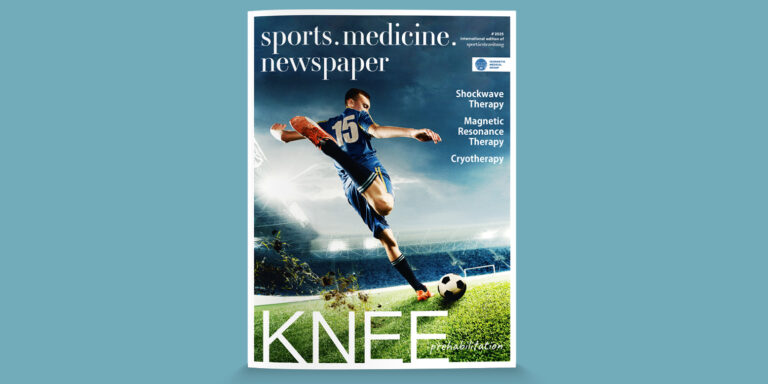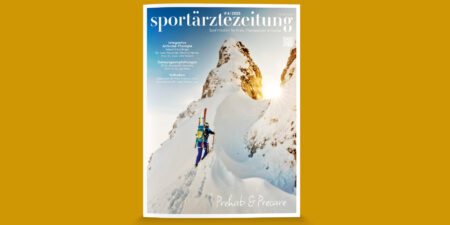Have you also noticed that reports of successful therapy in professional athletes are presented at almost all events on sports medicine (congresses, symposia, continuing education events, etc.), but almost never in the context of clinical studies? There are many understandable reasons for this, but our knowledge of optimized therapies for these patients remains limited as a result.
So I was all the more delighted when Javier Crupnik from Buenos Aires, Argentina, approached me a few years ago to ask if I would be willing to co-supervise his doctoral thesis in sports medicine. Javier Crupnik is not just anyone; among other things, he was the head physiotherapist for Argentina’s men’s national volleyball team. His many contacts in professional Argentinian sports enabled him to treat players from a prominent club in the province of Buenos Aires who had suffered acute type 3b hamstring injuries according to Müller-Wohlfahrt, as part of a randomized controlled study. All patients were at the level of US college athletes and had received scholarships for their studies, for example.
Now we really wanted to know: what can radial extracorporeal shockwave therapy (rESWT) (3 times a week, a total of 9 therapy sessions) achieve as an add-on to an absolute high-end physiotherapy and rehabilitation programme for such injuries? It is certainly no secret that the conditions in Buenos Aires are much more difficult than here in Germany.
Thanks to generous funding from Robert Erbeldinger (sportärztezeitung; Mainz, Germany) and Berthold Nickl (PRO Profil Gesellschaft für individuelles Karrieremanagement mbH; Putzbrunn near Munich, Germany), we were able to conduct the study at an extremely high level.
And we were not disappointed. A mean time to return to sport of 28.3 ± 4.5 days (mean ± standard deviation), achieved only by the high-end physiotherapy and rehabilitation programme, had not yet been reported in the international literature; many reported mean times to return to sport are sometimes significantly higher. And here, rESWT was even able to improve on this, reducing the mean time to return to sport to 25.4 ± 3.5 days. rESWT did not replace physiotherapy and the rehabilitation programme, but rather complemented it in a meaningful way.
Now, one could argue that the reduction of the mean time to return to sport by three days is not really significant and that the additional effort for the rESWT can be saved. In many cases, however, every single day counts (again for different reasons), and for an athlete’s annual salary of $250,000 or more, the additional expense of rESWT is also financially worthwhile for the club. It was a great time with Javier and we all say ‘Buenos días Argentina y gracias al Dr. Crupnik!’
Another study discussed here was much less spectacular, but certainly of equal relevance, albeit for a completely different patient group. In patients with tendinopathies of the supraspinatus tendon, in which partial tears have already formed, various physical measures, such as interference current therapy, short-wave diathermy and magnetic therapy, are often used, with good results. The main disadvantage of these therapies is the amount of work involved. So colleagues from the best medical school in China (Shanghai Jiao Tong University School of Medicine) approached me with the question of whether rESWT could help here – and it could. With 6 x rESWT (once a week for 5 minutes each time) the colleagues in Shanghai were able to achieve better results than with 30 x physical therapy (5 x per week for 45 minutes each time). In other words: treatment duration was reduced by 98 % and yet a better result was achieved… especially in China, but perhaps also for us, such improvements in treatment efficiency are of enormous importance.
Combined shock wave therapy for acute injury to the thigh muscle (type 3b)
In this controlled study of 36 semi-professional athletes (football, hockey, rugby), the hypothesis was tested that radial extracorporeal shock wave therapy (rESWT) + specific rehabilitation programme (RP) is more effective than sham rESWT + RP for acute hamstring injuries (type 3b). The results showed that the median time frame for return to sport was 25.4 days for the rESWT group and 28.3 days for the sham group, with the difference being statistically significant (p = 0.037). Both groups had similar satisfaction scores and only one patient from each group suffered a re-injury during the six-month follow-up period.
- Radial ESWT combined with a specific rehabilitation program (rESWT + RP) is more effective than sham rESWT + RP for acute hamstring muscle complex injury type 3b: a randomized, controlled trial
- Javier Crupnik, Santiago Silveti, Natalia Wajnstein, Alejandro Rolon, Tobias Wuerfel, Peter Stiller, Antoni Morral, John P. Furia, Nicola Maffulli, Christoph Schmitz
- medRxiv 2025.01.03.24319763; doi: https://doi.org/10.1101/2025.01.03.24319763
Radial extracorporeal shock wave therapy for rotator cuff injuries
In this study, 60 patients with rotator cuff injuries without complete tears were randomly assigned to either radial extracorporeal shock wave therapy (rESWT) or treatment with physical therapy methods (PTMs). The results showed that the rESWT group had significantly higher ASES total scores and lower VAS pain scores compared to the PTM group at 6 and 12 weeks post-treatment initiation. rESWT also resulted in a significant reduction in the thickness of the supraspinatus tendon and an increase in the acromiohumeral distance. This study suggests that rESWT is a more effective treatment method, which is also accompanied by a drastic reduction in treatment time.
- Radial extracorporeal shock wave therapy is more effective than a combination of physical therapy modalities for rotator cuff injury: a randomized controlled trial
- Zheng Wang, Lan Tang, Ni Wang, Lihua Huang, Christoph Schmitz, Jun Zhou, Yingjie Zhao, Kang Chen, Yanhong Ma
- medRxiv 2025.01.07.25320065; doi: https://doi.org/10.1101/2025.01.07.25320065
Radial extracorporeal shock wave therapy for Achilles tendinopathy
Radial extracorporeal shock wave therapy (rESWT) is an established treatment for Achilles tendinopathy. A recent investigation reported that the addition of rESWT to a specific training programme did not result in significant improvements in pain and function compared to placebo treatment. The main criticism of the authors is that the energy density of the radial extracorporeal shock waves generated with the rESWT device used in this study (operated at air pressure between 2 and 5 bar at 10 Hz frequency) was too low to achieve positive clinical results. Thus, the recent study by Alsulaimani and colleagues discussed here may not fully reflect the effect of rESWT, and it is suggested that further studies be conducted to investigate the energy flux density (EFD) of the rESWT device used by Alsulaimani and colleagues.
- Radial Extracorporeal Shock Wave Therapy for Insertional Achilles Tendinopathy: Energy Matters.
- Schmitz, C.; Crupnik, J.; Morgan, D.; Silk, E.; Maffulli, N.; Morral, A.
- Clin Rehabil. 2025 Feb 21:2692155251321013. Epub ahead of print.
Autoren
ist Inhaber des Lehrstuhls II der Anatomischen Anstalt der Ludwig-Maximilians Universität München und wissenschaftlicher Beirat der sportärztezeitung.




